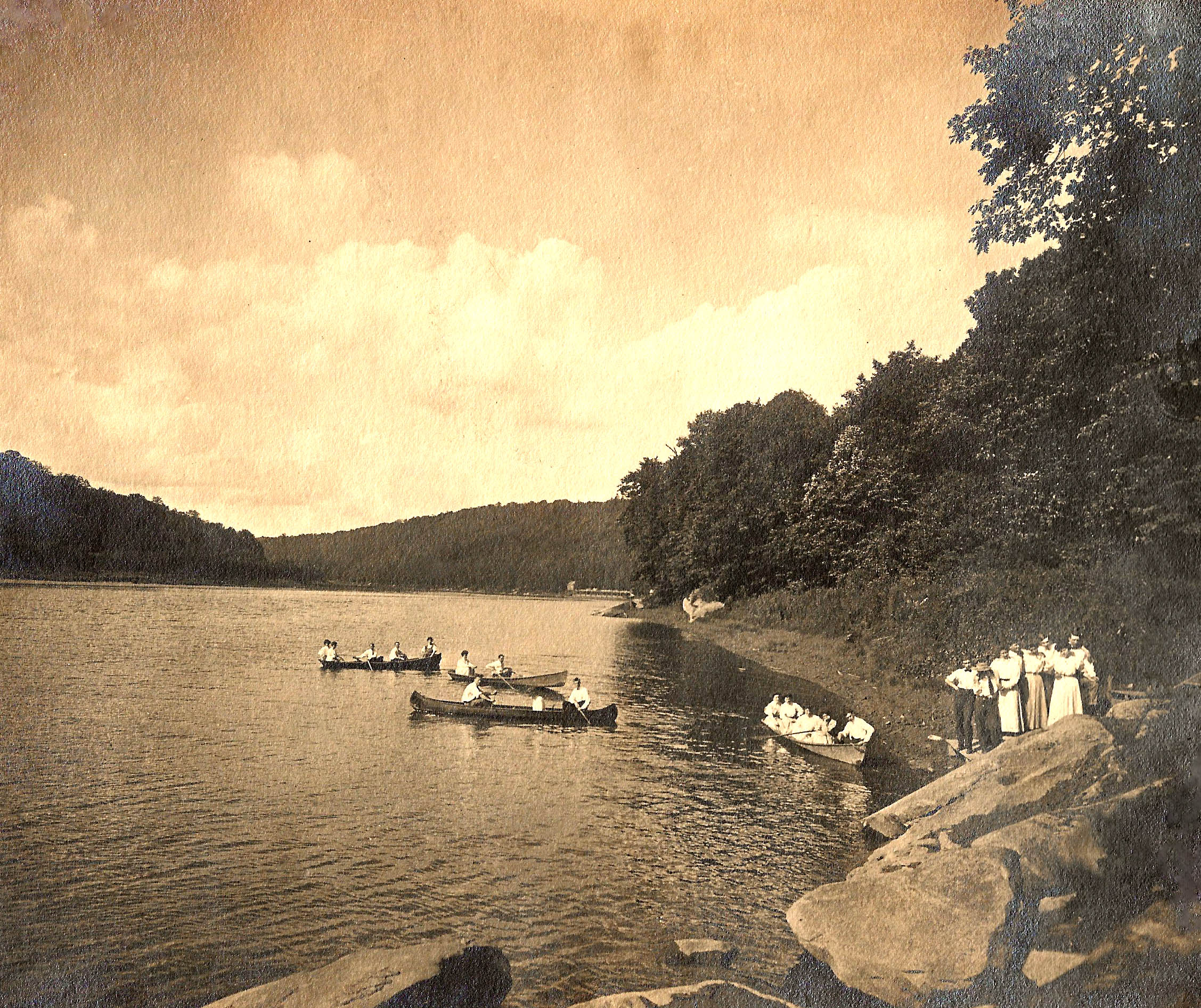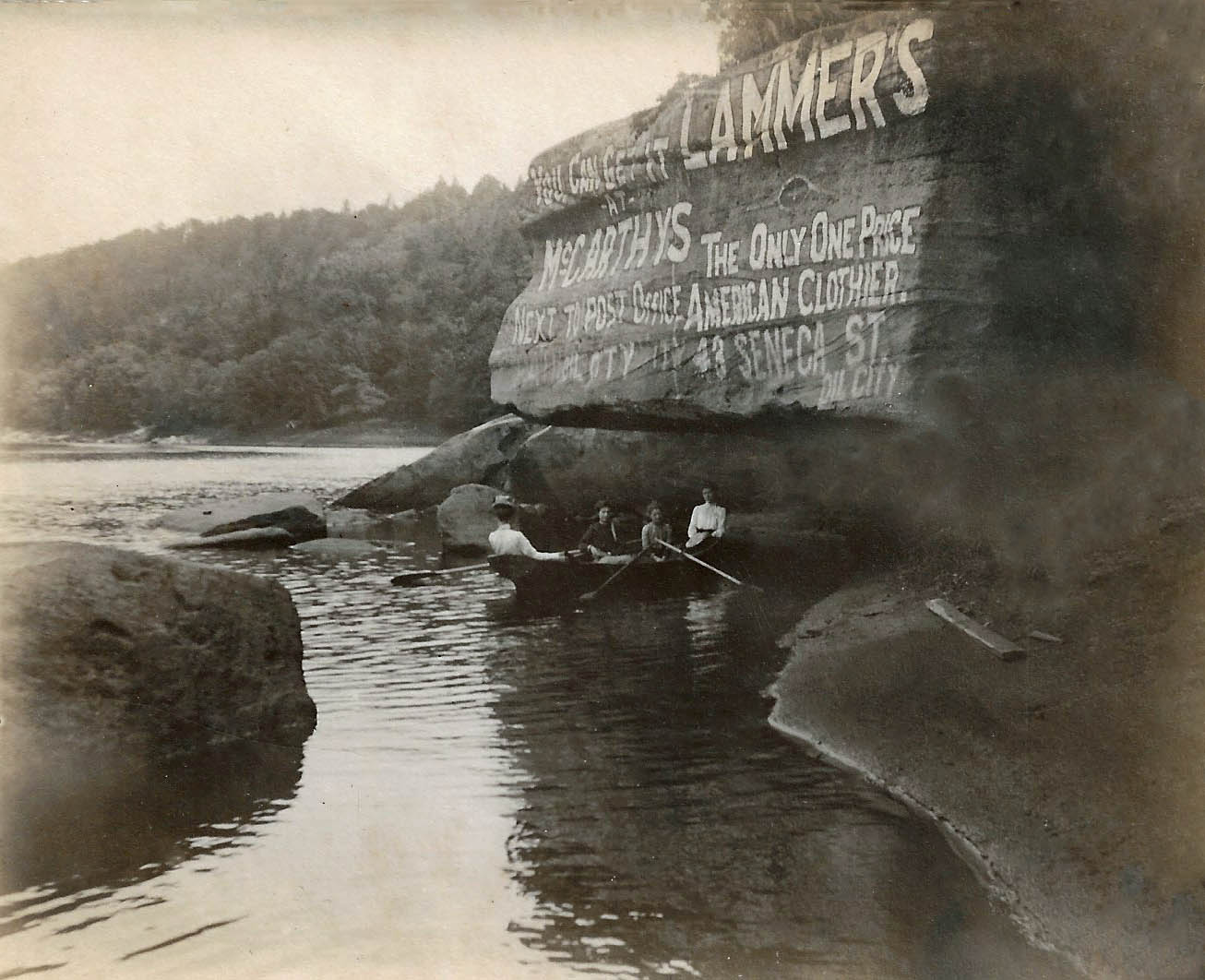Oil City Boat Club
- Judy Etzel
- August 5, 2022
- Hidden Heritage
- 6840
Financial success and a keen interest in finding a recreational outlet prompted a group of Oil City men to organize a social club that has flourished for more than a century.
In June 1887, a dozen Oil City businessmen met to discuss the creation of an organization focused on boating and other waterway activities. It was prompted by National Transit employees D.K. James, J.E. Robinson and H.L. Case who stored their boats, “safe from thieves, ice and high water,” up Horse Creek along the Allegheny River just north of Oil City.
A suitable plot of property was located near the mouth of Horse Creek and the riverfront acreage was leased from owner Eliza Miles. Within days, the local men had secured 31 charter members, drawn up a club constitution and by-laws and elected officers.
The next summer, the club members built a rough one-story clubhouse next to the old Horse Creek iron furnace. Travel to the club was limited to a horse-and-buggy trail that wound its way from the newly opened Oakwood Rose Gardens at the top of the hill down to the river.

A $10 entry fee, a hike in the dues to $10 and the prospect of levying other assessments to make property improvements were voted on. The membership roster expanded to 35 men.
Clubhouse Expands
By the 1888 summer season, a $44 bid was accepted to build a 10-by-14-foot kitchen annex, a lean-to, onto the existing clubhouse. During the next three years, the enthusiastic members continued to make small improvements to the clubhouse and surrounding property. In the spring of 1890, the club leased more adjacent land. Arrangements were made to provide natural gas service to the club. Approval was obtained to tap into a nearby spring for water.
On March 5, 1892, incorporation papers for the Oil City Boat Club were filed in Venango County court. The club charter noted the corporation was formed “for the purpose of the maintenance of facilities for boating and other innocent and athletic sports including a club for such purposes.” There were 34 members at the time with the directors listed as B.C. Simpson, W.R. Lay, A.P. Richey, D.K. James and Millard Scheide. The by-laws included: the club could incur no debts; membership was limited to males 21 or older; members could store only one boat at the club; members were ousted if their dues were 30 days in arrears; guests (limited to those living within a five-mile radius) could visit no more than once a month.
Arrangements were made to allow for the winter storage of a unique and large floating boathouse as well as members’ skiffs to be hauled up Horse Creek for safety from ice and high water. A caretaker, John M. West, was hired in July 1892 and would serve as janitor and club superintendent for nearly 40 years.
Train Service Begins
Transportation to the rapidly growing Boat Club was arranged in 1893 in a deal with the New York & Pennsylvania Railroad. The railroad agreed to schedule a special train to leave Oil City at 5:05 p.m. daily during the summer and stop at a designated site across the river from the Boat Club. The return trip was set for 10:30 p.m.
Access to the club would be via a ferry, or flat-bottom boat, that was attached to an overhead cable stretching from one side of the river to the other. The club hired a ferry master to transport the club-goers. During weekly summer dances at the club, the ferry would often be anchored at mid-river with a full band performing on the barge.
Club Grounds Expand
The club purchased more land and secured rights-of-way over the next three years. The properties were purchased from William L. Lay, Eliza Miles, Star Oil Company, B.F. Brundred, N.H. Brown and O.H. Strong.
In order to more fully entertain its members, the club board agreed to construct a building to house two bowling alleys, purchase more boats, buy a naptha-powered launch boat for members’ use, build two tennis courts in front of the old iron furnace, erect an ice house to store ice cut from the frozen Allegheny River, cleared areas along the river bank for picnics and other gatherings, created a floating boathouse for boat storage and more.
As the club grew, the board reached an agreement with Orian Siggins, who operated a sawmill up Horse Creek, that would allow him to use the bridge to haul his timber in exchange for him making improvements to the span. At the time, a full-sized road from Oil City to Rockmere had just been completed. The club directors voted to end its ban on renting land to persons wishing to build cottages when W.W. Splane offered land on the road above the club for use as building lots. The Boat Club bought the property, divided it into lots and made them available for rent at $12 a year.
New Clubhouse
In June 1910, the Boat Club board of directors agreed to contract for a new clubhouse. Bonds totaling $8,000 were issued and a contract was arranged with H.C. Mundt to build it. The club agreed to furnish the rough hemlock and stone needed to construct the building. The board budgeted $500 to furnish cutlery, china, glassware and other items and another $958 to build a river-retaining wall. The final cost came in at $11,605 for two sections: a two-story structure with a living room, kitchen, locker rooms, men’s lounge and a massive fireplace which sported a mantle inscribed: “Hang care: care would kill a cat. Therefore, let us be merry”; the adjoining area was a one-story ballroom with a huge fireplace and five pairs of glass doors.
Completed in June 1911, the new Boat Club was formally dedicated with a party on July 1. Two special trains filled with club members and their guests left Oil City bound for Rockmere.
During that summer and continuing for a decade, the Boat Club would provide cooked meals to its members, maintain a floating boat house, operate a 30-person launch, offer a bowling alley, provide private rooms for members, construct a tennis court and more.
The Boat Club continued to prosper, adding new members and expanding its social calendar. However, it was hit with a major fire in 1946 that destroyed the two-story portion of the club, leaving only the 1911 ballroom and veranda standing. Three years later, the board approved the construction of a new club wing. The cost of the one-story, cinder block addition, built by L.O. Bouquin, was pegged at $45,652.
Written by Judy Etzel with research by Kay Dawson and design by Natalie Cubbon.
HIDDEN HERITAGE IS SPONSORED BY:
Oil Region Alliance
Gates & Burns Realty
Support This Project
Donations to the library are appreciated to help offset printing costs & make this project possible! Want to become a sponsor? Email us at promotions@oilregionlibraries.org to get started!
Make a Donation










